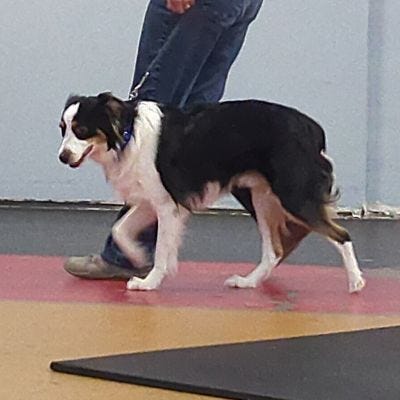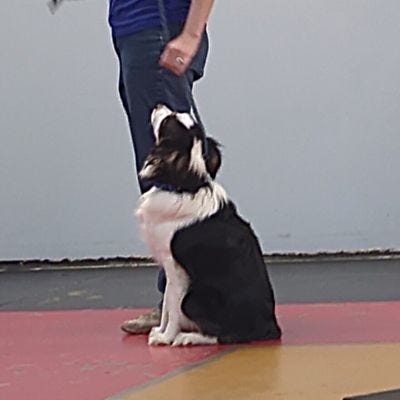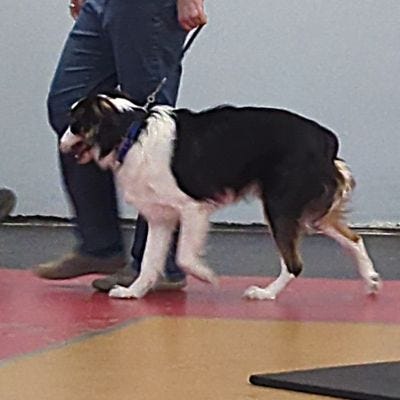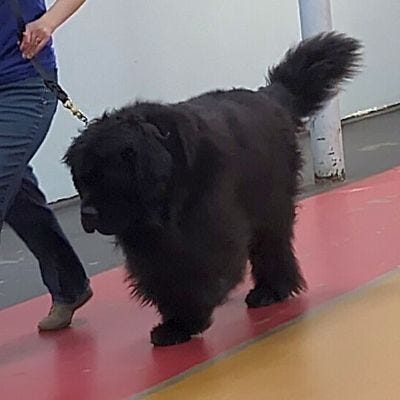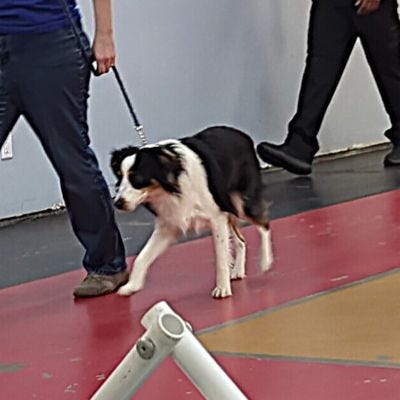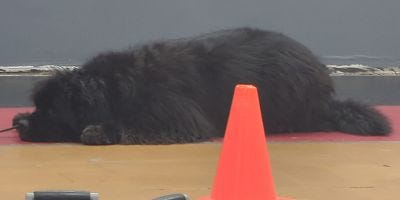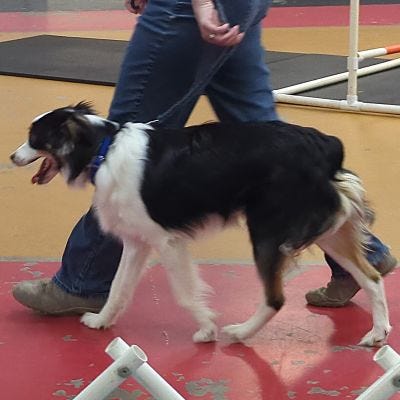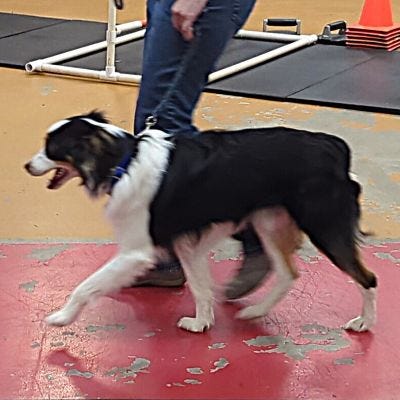Leash Lessons: Heel with Auto-Sit
Master the Heel with Auto-Sit: From leash introductions to perfect sits. Join Dante and Crokell on their cosmic journey from worst to best. Unleash your dog's inner star!
This week Dante started in a new obedience class. I think we are going to stick with this new one because of having quicker responses (from Crokell) and getting auto-sits up and running almost immediately (with Dante). The faster responses and more focus from Crokell are especially helpful.
So today’s exciting edition of Chaos Critters Leash Lessons will talk about heel with auto-sit, something Crokell and I struggle with a lot. If you are competing with your pet you will recognize this as the foundation work is used in obedience, rally, trick dog, and most AKC events. This essential command not only strengthens your bond with your furry friend but also keeps them safe during adventures or walks. When you stop, they should stop and sit - not go charging off without you. So grab a leash and your pooch and let’s get started!
Today, was Dante’s first class and he was happy and jumping and so excited, I was almost surprised he didn’t wet the floor. He moved around, wanting to meet everyone and everything, but settled down a little when we started walking. The instructor who had only met and worked with Crokell before, was surprised by Dante who was much more easily distracted. That being said, Dante, responded well to the quick little corrections and lavish amount of praise he got. By the end of the class his auto-sit was better than Crokell’s currently is… Although his stay still needs work because he wanted to run and say “hi” to the instructor every time they got within a few paces of each other.
Crokell on the other hand excels at stay, to the point where, during a stay, the instructor was playing with Crokell’s tail and asked, “Is this thing even attached to the other end?”
For more information on stay, take a look at our older post on how to train stay. The fun of having two completely different breeds is that stay is Crokell’s best trick and Dante’s worst. Heel is looking to be Dante’s best trick and is Crokell’s worst.
Teaching Your Newest Critter to Heel
Teaching your dog to heel with an automatic sit is a rewarding process that combines leash sensitivity, positive reinforcement, and well-timed corrections. In the beginning when you introduce the leash, you want them to be aware of it but also to have positive associations with it, so treats or praise are great.
The Adventure Begins: Introducing the Leash
Get Your Dog Acquainted with the Leash
Start by letting your dog wear the leash indoors while playing with treats and toys aka when they want to be close to you. This makes the leash a fun companion rather than a restrictive accessory. You also reward as they react to the leash. A general tug or pressure, if they turn toward you mark it, praise it or reward it. This something I saw Kikopup use when training on You Tube and thought it was a wonderful idea. Especially with “young” pups who have little to no sense.Treats for Sensitivity
Hold the leash gently and use treats to guide your dog into following you. Reward them for staying close and building their awareness of leash tension. It's like playing a game of "Follow the Leader"! I think this works best with new young dogs, but even with an older dog it can be helpful to make them want to be on leash.Short Bursts
But even with getting them used to it, you want your pup to respect the leash. Tension is bad and will lead to “pulling” a dog through in competition, or lack of sensitivity. So you want to reward the dog for fast response (treats) but you also want corrections to be very quick and short - a light jerk to get their attention. This is something I struggle with, especially with Crokell because it is less sensitive which is on par for the breed. But Dante responds quickly (most of the time).
The Heel Harmony
Lure Into Position
Use a treat to guide your dog into the heel position (on your left side, aligned with your leg). Mark and reward when they are in the correct position. You can also do this without treats. You can reward with pets and praise, for some dogs this is more than enough. When you are standing still, they should be sitting. When you are moving, they should be keeping up with you. It's like finding the perfect dance partner and the perfect rhythm.Introduce the "Heel" Command
Once your dog consistently follows the lure, say "heel" right before they move into position. Gradually reduce luring and rely on the verbal command.Practice Movement
Begin walking slowly, rewarding your dog for staying beside you in the heel position. If they pull ahead or lag behind, stop and reset their position using treats or leash guidance.
The Grand Promenade with Automatic Sit
Introduce Sit at Stops
During walks, stop periodically and use a treat or light upward leash pressure to guide your dog into a sit when you halt. Pair this with a marker word like "yes" and reward immediately. (You can also say “sit” if the dog knowns sit, but this can confuse them when you take the command away.)Cultivating Consistency
Repeat this every time you stop walking so your dog begins to anticipate sitting without needing a cue. Consistency is key to making this behavior automatic. And let me tell you, consistency is hard! Usually, the "signal" in competition for the auto-sit is bringing your feet together.
But here's a fun tip: stop moving your right foot first. Then move your left foot up to the front to meet the right foot. It's like doing a little dance move - right foot leads, left foot follows, and voila! Your pup sits… Except I often have trouble with left and right.
The left foot is closest to your dog. It’s what they notice. Start moving the left foot first, and your furry pal moves with you. Start with your right foot, and they learn that means “wait for a command”.
Consider it akin to a graceful minuet, where your left foot plays the role of principal dancer. Your devoted friend should, and in time shall, observe your elegant footwork as though you were the very pinnacle of society's grace.
Should you find yourself confounded by left and right, as I usually am, consider "left" as the "canine" side and "right" as the "empty" side. As dogs should mostly heel on the left this has served me (mostly) well.
The Art of Gentle Guidance / Connect and Correct
Importance of Timing and a Swift Corrections
If your dog strays from the heel position or fails to sit, use a quick, sharp tug on the leash as a reminder. This keeps them attentive without causing prolonged discomfort. Consider it akin to a polite tap on the shoulder in refined society, as opposed to a slap and announcement dueling at dawn.The Folly of Prolonged Correction
Extended or sustained pressure will desensitize your pup, rendering them less responsive as time progresses. They end up depending on being pulled through the action, instead of learning to do it. Swift corrections, coupled with immediate rewards for prompt responses, will keep them on their toes, their wit sharp and their attention on you. Quick corrections paired with immediate praise or rewards help maintain sensitivity. It's all about balance!
Tips for a Pawsitive Experience
Reward Generously at First: Use treats (or better yet, praise) frequently during early training stages to build positive associations with heeling and sitting.
Gradually Reduce Treats: Once your dog performs reliably, transition to intermittent rewards while maintaining verbal praise.
Keep Sessions Short: Limit training sessions to 5–10 minutes to keep your dog engaged and prevent frustration.
Practice in Different Environments: Dogs struggle with generalization, so practice in various locations to strengthen their understanding of commands.
Stay Calm and Consistent: Your timing and consistency are critical for success.
Foot work: What you do with your feet matters. Make sure you are consistent. Even if you end up with a different dance step then what I suggested, if you are consistence your dog will likely learn it as a command.
Why Short Corrections Work
Short corrections are effective because they serve as a clear signal without overwhelming or confusing the dog. Long corrections can cause frustration or desensitization, reducing responsiveness over time. By keeping corrections quick and pairing them with rewards for correct behavior, you create a balanced approach that encourages learning and attentiveness.
The dog also doesn’t learn to depend on being guided by pressure from the leash.
With patience and consistency, you'll have a dog that heels beautifully and sits automatically at every stop!
Someday Crokell may too!
Tip of the Week
If earning an AKC title or three isn’t enough motivation to teach your pup auto-sit think of how the intergalactic council will view animal trainers - they’re the only people that can get a species they can’t talk with to do what they need or want on command. Such tricks are sure to earn the best trainers seats on the Galactic Council, so prepare to negotiate intergalactic peace treaties and receive a lifetime supply of cosmic treats. But it all starts with a good heel.
Critter's Weekly Question
What's the most creative reward you've used to encourage your dog to stay in heel or to master the automatic sit? Share your clever ideas and inspire others to find their own unique motivators!


